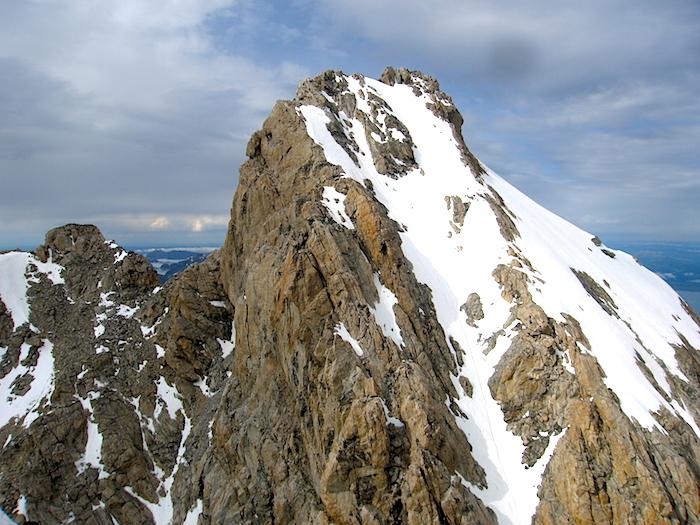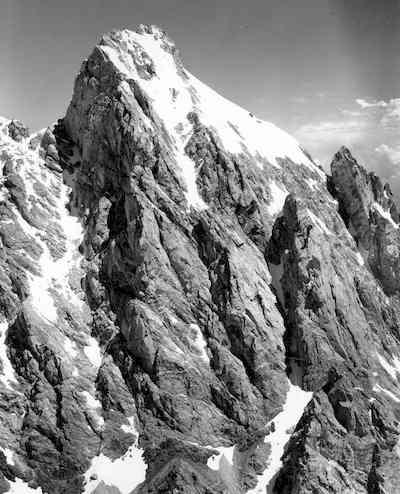
The summit of the Grand Teton, in Grand Teton National Park, is a tempting goal for climbers/NPS
Climbing in the Tetons of Grand Teton National Park can be an exhilarating experience, but it also can be unforgiving and, at its worst, deadly. A band of climbers who tried to summit the Grand Teton in a long one-day slog narrowly avoided tragedy and in the end were rescued from a snowmelt-drenched couloir by rangers and other climbers on the mountain.
August is prime season for climbing the 13,770-foot patriarch of the park's namesake range, and that played a role in the climbers' plight. The ten -- in two separate parties, one of six, the other of four -- had hoped to summit and descend the Grand Teton last Saturday.
"Jerry Painter, 59, of Idaho Falls, Idaho, served as leader for his climbing partners Chris Hanvit, 55, also of Idaho Falls, Holly Preslar, 27, of Sugar City, Idaho, Jacob Preslar, 22, of Provo, Utah, Tina Reis, 24, of Rigby, Idaho, and Chelsea Principio, 24 of Phoenix, Maryland. Painter’s group began their push for the summit of the Grand Teton at 7 a.m. from the Lower Saddle," park spokeswoman Jackie Skaggs noted in a release on the rescue. "They intended to climb the Petzoldt Ridge, but had a discussion prior to departing about changing their objective because of the time of day and the crowding on the route. They ultimately stuck with their original plan. After encountering other climbing parties and getting delayed—plus moving slowly due to their large size—they did not arrive at the top of the Petzoldt Ridge until 5 p.m. Saturday, and they were still a considerable distance from the summit of the Grand.

Ten climbers became trapped in the Stettner Couloir -- the shaded ravine on the right side of the photo -- by snowmelt and rope problems/Leigh Ortenburger via NPS
"The Painter party encountered a party of four climbers led by Mike Hagen, 25, of Moran, Wyoming. Hagen and his partners Nicolas Aguirre, 20, also of Moran, Ryan Moorhead, 28, of Colorado Springs, and Nancy Nguyen, 23, of El Monte, California, were also climbing the Petzoldt Ridge," Ms. Skaggs said. "Following a discussion about the most expedient descent route, both parties ended up independently rappelling into the Stettner Couloir. Both groups also become separately stranded when their ropes got stuck and they could not continue to rappel."
The Stettner Couloir, named for immigrant brothers Joe and Paul Stettner who gained fame for their climbs in Colorado's Rocky Mountain National Park and the Tetons in the 1920s and 1930s, for much of the year is filled with snow. But that not often is the case in summer.
"Climbing in the Stettner Couloir can be difficult during summer months because the floor of the couloir essentially becomes a waterfall, with steep, wet and polished rock walls," wrote the park spokeswoman. "A constant flush of snowmelt—and the tendency for repeated rockfalls—makes this route a challenge. The climbers encountered several icy waterfalls, and rescuers witnessed dislodged boulders and other debris sloughing down slope as they approached the stranded climbers’ location mid-morning on Sunday."
While the first call for help was received about 8:45 p.m. Saturday, it took nearly 24 hours for all 10 climbers to be helped off the mountain. A ranger did hike from the Jenny Lake Rescue Cache at Lupine Meadows seven miles, and 5,000 feet up in elevation, Saturday night to the Lower Saddle. At the same time, rangers, noting that rescue options probably could not be put into action until Sunday morning's first light, suggested to Preslar and her team that they try to either continue down the couloir or "find a safer and drier place to huddle up for the night."
"At 11:30 p.m., Preslar called to inform rangers that the two climbing parties had combined forces in an effort to make it down and out of the couloir, and she had high hopes that the climbers would make it to the Lower Saddle before morning," Ms. Skaggs said. "Two of the climbers, Hagen and Reis, eventually made their way to the Lower Saddle by 12:30 a.m. Sunday and were given a sleeping bag and food by rangers at the rescue hut. They were also able to provide more information about the predicament that their stranded partners were encountering."
The icy water falling on those back in the couloir was a problem, as several of the climbers were wearing out and becoming hypothermic from the cold and wet conditions. Rather than chance the down climb in such condition, the group decided to stop and wait for daylight.
Rangers received a text message at 5:50 a.m. Sunday that said, “Still stuck in the couloir. Very wet and cold. Need to get out ASAP.”
"At first light, two rangers headed out on foot from the Lower Saddle’s rescue hut to climb to the scene, assess the situation, and ideally arrange for an evacuation by the Teton Interagency contract helicopter. Because high winds prevented use of the ship, three additional rangers hiked from the Lupine Meadows trailhead to reach the rescue staging area on the Lower Saddle and prepare for a ground rescue," noted Ms. Skaggs. "Once the high winds subsided, three additional rangers were flown to a backcountry landing zone located on the Lower Saddle, and they also joined in the rescue operation.
"Rangers also enlisted the help of four guides from Exum Mountain Guides, and two private climbers, who happened to be in the vicinity. The two private climbers accompanied one ranger to the rescue site, and the Exum guides helped the group across the Black Dike traverse after they were free of the couloir."
By Sunday afternoon, the eight climbers had reached the Lower Saddle rescue hut where they were given food and hot drinks by rangers, who assessed their physical condition to determine who might need aerial evacuation. Four of the ten climbers (Hanvit, Principio and the two Preslars) were evacuated via helicopter at 3 p.m. and flown down to the Jenny Lake Rescue Cache on the valley floor. The remaining six climbers hiked out of the mountains on their own.
"Although none of the ten climbers sustained injuries during their mountain mishap, several did suffer from exposure to the extremely wet and cold conditions that they experienced during their hours-long descent of the Stettner Couloir," said Ms. Skaggs.
Grand Teton rangers strongly advise that climbers thoughtfully consider their skills, abilities and limitations before undertaking a climb of the Grand Teton and other peaks throughout the Teton Range. Climbers should also consider the time it takes to complete an excursion and realize that the size of a group, and other climbers on the same route, can increase the time it takes to complete a climb, said Ms. Skaggs.
Climbing partners should not rely solely on the skills and problem-solving abilities of one member of the group. To ensure a safe and successful climb, each party member needs to be competent in navigating the vertical terrain, as well as the chosen route, and each should be capable of making good decisions in a mountain environment, she said.



Add comment